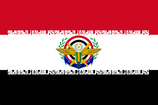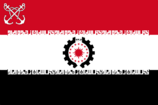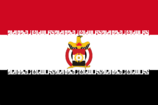Flag of Zorasan
This article is incomplete because it is pending further input from participants, or it is a work-in-progress by one author. Please comment on this article's talk page to share your input, comments and questions. Note: To contribute to this article, you may need to seek help from the author(s) of this page. |
 | |
| Name | Parčam-e Zafar (Victory Banner) |
|---|---|
| Use | National flag and ensign |
| Proportion | 5:8 |
| Adopted | 1 January 1980 |
| Design | A horizontal triband of red (top), white middle and black, with the Emblem of the Union Fathers superimposed at the center, and "Zorasan Zindabad" (Long Live Zorasan) written in Kufic script in white, repeated four times along the bottom edge of the red band and 11 times along the top edge of the black band, for a total of eight times on the edges of the bands. |
| Designed by | Nazim Zaheed |
 Variant flag of Zorasan | |
| Use | War flag |
| Proportion | 2:3 |
| Adopted | 1 January 1980 |
| Design | Red-white-black triband with emblem of the Zorasani Irfanic Revolutionary Army superimposed in centre. |
 Variant flag of Zorasan | |
| Use | Naval ensign |
| Proportion | 2:3 |
| Adopted | 1 January 1980 |
| Design | National flag with two white fouled crossed anchors in canton. |
 Variant flag of Zorasan | |
| Name | State Presidential Standard |
| Use | Civil ensign |
| Proportion | 2:3 |
| Designed by | National flag with the national emblem superimposed in the centre. |
The Flag of Zorasan (Pasdani: زرصانی پرچم , Parčam-e Zorasān;Rahelian: علم القرنان, Alam al-Kurṣān) is a horizontal triband of black-white-red, with the popular chant of "Zorasan Zindabad" (Long live Zorasan) written in kufic script four times on the edges of the red and black bands, and the Emblem of the Union Fathers superimposed at the middle of the flag and white band. Within Zorasan, officially and popularly, it is referred to as the "Victory Banner" owing to its adoption in wake of Zorasani Unification in 1980.
The flag was officially adopted on 1 January 1980, with the founding of the Union of Zorasani Irfanic Republics and was designed by Nasir Zaheed between 1978 and 1979. The colours utilised were adopted from the Flag of the Union of Khazestan and Pardaran, the UZIR's official legal predecessor state. The red-white-black triband was introduced in the early 1930s by the Pardarian Revolutionary Resistance Command, during its guerilla campaign against Etruria, the triband's colours were selected by Mahrdad Ali Sattari personally.
The flag is often used alongside the PRRC triband, which is the red-white-black triband without any other features, which is officially designated the "Revolutionary Banner."
Design and symbolism
With the exception of the superimposed Emblem of the Union Fathers and the kufic script, the triband is an adoption of the Revoutionary Banner developed in the 1930s by the Pardarian Revolutionary Resistance Command. The coloured bands were afforded specific meaning by Mahrdad Ali Sattari; the red band representing the "blood spent in pursuit of freedom", the white band representing the "purity of spirit" and the black band representing "armed struggle." As the meanings were universally ideologically, it was adopted by the Union of Khazestan and Pardaran and its meanings expanded to all peoples of Zorasan. Following the end of the Second Rahelian War and the unification of Zorasan, calls for a new flag design were issued.
While the colour bands were to be retained, though adaptions were requested to truly "present the unification of the Zorasani and Sattari people." In 1978, Nazim Zaheed an artist from Khazestan was chosen by the government to present designs. Zaheed had prior to 1978, produced the design of the Emblem of the Union Fathers, a sixteen-pointed star (representing the modern Zorasani nation-state) surrounded by sixteen individual stars (each representing the individual historic nations that encompassed modern Zorasan as a single polity) and encompassed by a bisected cog, representing "modernity and industry." The only modification made to the Emblem of the Union Fathers on the flag was the addition of the year 2302 (1980) of the Solar Hijri calendar to the top bisected section of the cog - the date of the UZIR's founding.
Zaheed opted to utilise his emblem, while also producing the kufic script, which emerged in Rahelia during the middle ages, but is used to write "Zorasan Zindabad" (Long Live Zorasan), a Pasdani chant and slogan. Zaheed argued that a Pasdani slogan written in a Rahelian script would embody the unification of the two languages and cultures through Zorasan.
Colour scheme
| Light Maroon | White | Black | |
|---|---|---|---|
| RGB | 206/17/38 |
255/255/255 |
0/0/0
|
| Hexadecimal | #ce1126 |
#FFFFFF |
#000000
|
| CMYK | 0/92/82/19 |
0/0/0/0 |
0/0/0/100
|
Protocol and use
State institutions
In accordance to the Zorasani constitution, the flag is always featured at every state-owned building including, the Supreme Assembly, ministries, military, schools, councils, state buildings, provincial offices, district offices, bridges, airports and cemetaries.
Uniforms
On military uniforms the flag is displayed on a patch on the right shoulder and or the front of the uniform. Helmets can display the flag too on the sides. Flight suits, navy uniforms, National Protection Force uniforms and others feature the flag on shoulder patches and or helmets. Along with uniforms several emblems and patches display the flag with prominence or minor alteration.
Days of display
Zorasan celebrates many national events such as religious festivals, battle victories and Unification Day. It is common for local authorities to distribute flags to people celebrating such events. On other occasions the public uses the flag heavily when protesting is permitted, or commemorating certain events or deaths respectively. Statues and monuments may be draped with the flag while marches and songs are played - since 2006, it is mandated in law that during national events, local authorities arrange for statues or monuments to be draped in the national flag, be it physically or via light projection. On television screens the flag is displayed in celebration of such events too with the portrait of Mahrdad Ali Sattari next to it. The flag may also be presented at half staff in mourning of tragic events or important days.
Funerals
The flag has a prominent display on state and military funerals. A burial flag is always draped over the deceased coffin and is carried by the military's dedicated Martyrs and Funeral Guard. The family of the deceased may select which flag is draped over the coffin, with the options being the national flag, revolutionary flag or the war flag (if they served prior or at the time of their death). It is mandatory under law that attendants of state and military funerals wear the national flag on their lapels, as well as holding images of the deceased.
Revolutionary Banner and officially authorised variants
The Zorasani government officially recognises a variety of flags that may be flown on official occassions alongside the national flag. The most common is the Revolutionary Banner (Parčam-e Inqelabi), which is the red-white-blank triband without the kufic script or emblem superimposed. The Revolutionary Banner was introduced in the 1930s by Mahrdad Ali Sattari, the leader of the Pardarian Revolutionary Resistance Command, founding father of the Union of Khazestan and Pardaran and the most prominent national hero within Zorasani society. The banner was used extensively during the PRRC's struggle to secure Pardaran's independence from Etruria and during the Pardarian Civil War. Following the war's end, the triband became the symbol of Pan-Zorasanism and would be adopted by the Union of Khazestan and Pardaran in 1953.
The second officially recognised variant is called the "Union Father Banner" (Parčam-e Ettehad-ye Pedar), it was designed in 2011 by 16-year old student, Mostafa Al-Malki as part of a national competition launched by the National Renovation Front. It is the revolutionary banner with a silouhette of Mahrdad Ali Sattari in his military garb dated from 1936 superimposed on the centre. The flag was officially recognised by the government in 2013 and was mandated to be used at political rallies, National Renovation Front events, sports events and national celebrations, by people. It is not displayed on flag staffs.
Organisational flags
Three organisations operate offically recognised variants of the national flag, the National Renovation Front, the Young Companions of the Union and the Young Students of the Union. Notably, the flag of the NRF and YCU differ from the national flag in several ways.
The flag of the National Renovation Front was adopted in 1979 following its founding, but differs from the national flag by the shade of red used in the top band of the horizontal tricolour. The shade is lighter than than the national flag, reasons for this difference range from a mistake in design, to a purposeful alteration for viewing purposes by television. The design of the triband is done to fit around the diamond-shaped logo comprised of the party name repeatedly written in kufic script, in the colours of the national flag.
The flag of the Young Companions of the Union was introduced in 1980 is comprised of the triband with the emblem of the youth movement superimposed over the centre. The emblem consists of a boy blowing a trumpet and flanked by bars forming a crescent ascending toward a circle containing a silouhette of Mahrdad Ali Sattari (which was introduced in 2012), the Emblem of the Union Fathers sat in its place from 1980 to 2012. The dimensions of the YCU flag also differ, which has a reduced width.
The flag of the Young Students of the Union was introduced in 1982 and redesigned to its current form in 2010. It its the revolutionary triband with the emblem of the student organisation superimposed on the centre, which consists of a pattern surrounding the silouhette of Ali Sattari and below, the organisation's name in kufic script.
Military flags
Flags of the Union Republics
Historical flags/Foreign-involved flags
Flag of Etrurian Rahelia (1860-1946); Etrurian dominion
Flag of the Ninavina (1861-1946); Etrurian colonial protectorate
Flag of the Cyracana (1860-1946); Etrurian dominion
Flag of the Shahdom of Pardaran (1860-1950)
Flag of the Pardarian Revolutionary Resistance Command (1934-1950) and the Zorasani Republic of Pardaran (1950-1952)
Flag of the Kingdom of Irvadistan (1946-1953)
Flag of the Confederation of Riyadha (1946-1953)
Flag of the Kexri Republic (1946-1952)
Flag of the Zubaydi Rahelian Federation (1953-1968)
Flag of the United Rahelian People's Republic (1968-1977)
Flag of the Union of Khazestan and Pardaran (1952-1980)
















